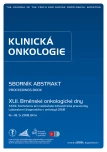Usage of Cerebrospinal Fluid for microRNA Analysis
Authors:
A. Kopková 1; J. Šána 1,2; M. Večeřa 1; D. Knoflíčková 1; M. Smrčka 3; O. Slabý 1; P. Fadrus 3
Authors‘ workplace:
CEITEC – Středoevropský technologický institut, MU, Brno
1; Klinika komplexní onkologické péče, Masarykův onkologický ústav, Brno
2; Neurochirurgická klinika LF MU a FN Brno
3
Published in:
Klin Onkol 2018; 31(Supplementum1): 158-160
Category:
Article
Overview
Backgrounds:
Deregulated levels of miRNAs, short noncoding RNAs associated with pathogenesis of many diseases, have been observed in cerebrospinal fluid (CSF). Therefore, the analysis of CSF miRNAs in patients affected by tumors of central nervous system (CNS) might help to develop new diagnostic platform enabling more precise diagnosis. Thus, in our study we tried to optimize methodical approaches to be used for miRNA detection as RNA isolation and selection of suitable technology for global high-throughput miRNA profiling.
Material and Methods:
In the optimization phase of RNA isolation from CSF, various commercially available kits with different protocol modifications were compared. Two quantitative polymerase chain reaction panels and Next Generation Sequencing method were tested for selection of the most suitable method for miRNA comprehensive profiling.
Results:
The Urine miRNA Purification kit (Norgen) and Next Generation Sequencing was selected as the most suitable kit for RNA extraction from CSF and method for miRNA comprehensive profiling, resp.
Conclusion:
We established a protocol for RNA isolation and miRNA comprehensive profiling in CSF clinical specimens.
Key words:
brain neoplasm – cerebrospinal fluid – microRNA
The authors declare they have no potential conflicts of interest concerning drugs, products, or services used in the study.
The Editorial Board declares that the manuscript met the ICMJE recommendation for biomedical papers.
This study was supported by Ministry of Health of the Czech Republic, grant No. 15-34553A. All rights reserved.
Submitted:
19. 3. 2018
Accepted:
10. 4. 2018
Sources
1. Ahmed R, Oborski MJ, Hwang M et al. Malignant gliomas: current perspectives in diagnosis, treatment, and early response assessment using advanced quantitative imaging methods. Cancer Manag Res 2014; 6: 149–170. doi: 10.2147/CMAR.S54726.
2. Shalaby T, Grotzer MA. Tumor-associated CSF aicroRNAs for the prediction and evaluation of CNS malignancies. Int J Mol Sci 2015; 16 (12): 29103–29119. doi: 10.3390/ijms161226150.
3. Weston CL, Glantz MJ, Connor JR. Detection of cancer cells in the cerebrospinal fluid: current methods and future directions. Fluids Barriers CNS 2011; 8 (1): 14. doi: 10.1186/2045-8118-8-14.
4. Shalaby T, Achini F, Grotzer MA. Targeting cerebrospinal fluid for discovery of brain cancer biomarkers. J Cancer Metastasis Treat 2016; 2: 176–187. doi: 10.20517/2394-4722.2016.12.
5. Sana J, Hajduch M, Michalek M et al. MicroRNAs and glioblastoma: roles in core signalling pathways and potential clinical implications. J Cell Mol Med 2011; 15 (8): 1636–1644. doi: 10.1111/j.1582-4934.2011.013 17.x.
6. McAlexander MA, Phillips MJ, Witwer KW. Comparison of methods for miRNA extraction from plasma and quantitative recovery of RNA from cerebrospinal fluid. Front Genet 2013; 4: 83. doi: 10.3389/fgene.2013.00083.
7. Burgos KL, Javaherian A, Bomprezzi R et al. Identification of extracellular miRNA in human cerebrospinal fluid by next-generation sequencing. RNA 2013; 19 (5): 712–722. doi: 10.1261/rna.036863.112.
8. Sheinerman KS, Umansky SR. Circulating cell-free microRNA as biomarkers for screening, diagnosis and monitoring of neurodegenerative diseases and other neurologic pathologies. Front Cell Neurosci 2013; 7: 150. doi: 10.3389/fncel.2013.00150.
9. Bekris LM, Lutz F, Montine TJ et al. MicroRNA in Alzheimer’s disease: an exploratory study in brain, cerebrospinal fluid and plasma. Biomarkers 2013; 18 (5): 455–466. doi: 10.3109/1354750X.2013.814073.
Labels
Paediatric clinical oncology Surgery Clinical oncologyArticle was published in
Clinical Oncology

2018 Issue Supplementum1
- Metamizole vs. Tramadol in Postoperative Analgesia
- Metamizole at a Glance and in Practice – Effective Non-Opioid Analgesic for All Ages
- Possibilities of Using Metamizole in the Treatment of Acute Primary Headaches
- Current Insights into the Antispasmodic and Analgesic Effects of Metamizole on the Gastrointestinal Tract
- Spasmolytic Effect of Metamizole
Most read in this issue
- MicroRNA Analysis for Extramedullary Multiple Myeloma Relapse
- A Development and Overview of the Use of Chemotherapy and the Role of Radiotherapy and Surgery in Patients with Newly Diagnosed Pancreatic Tumor and Cancer in the Current 5-year Center Practice
- Flow Cytometric Analysis of Nucleoside Transporters Activity in Chemoresistant Prostate Cancer Model
- MicroRNAs in Prediction of Response to Radiotherapy in Head and Neck Cancer Patients – Pilot Study
